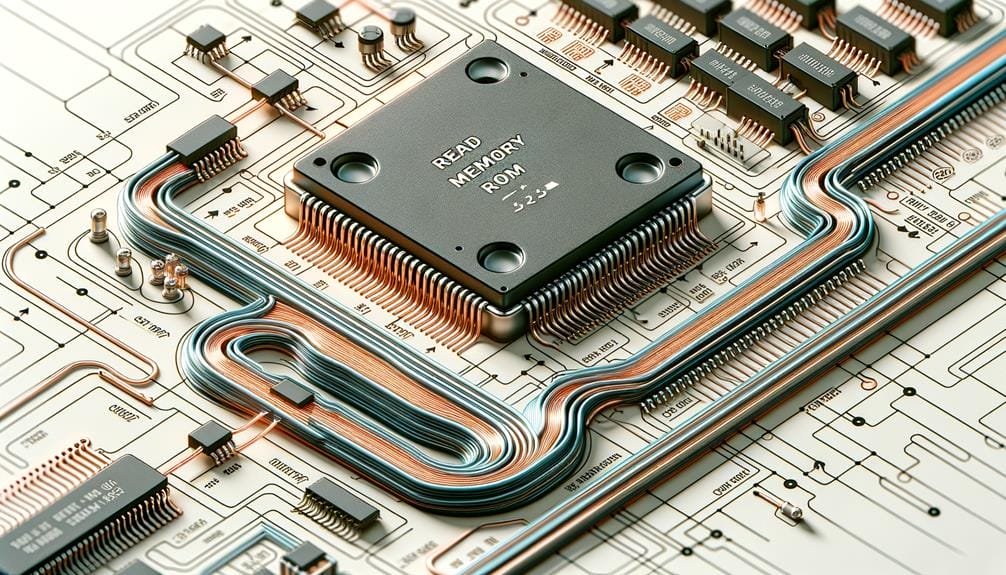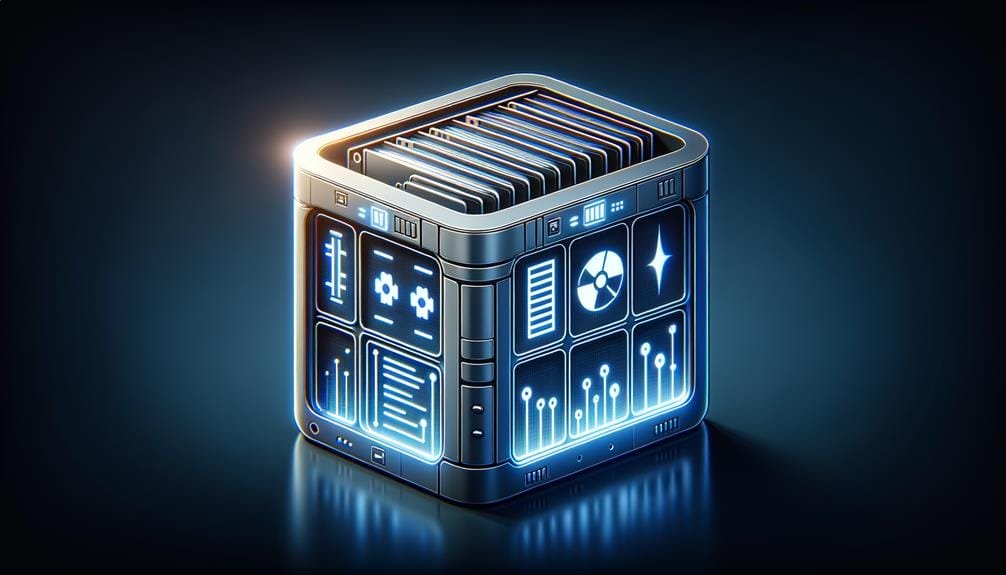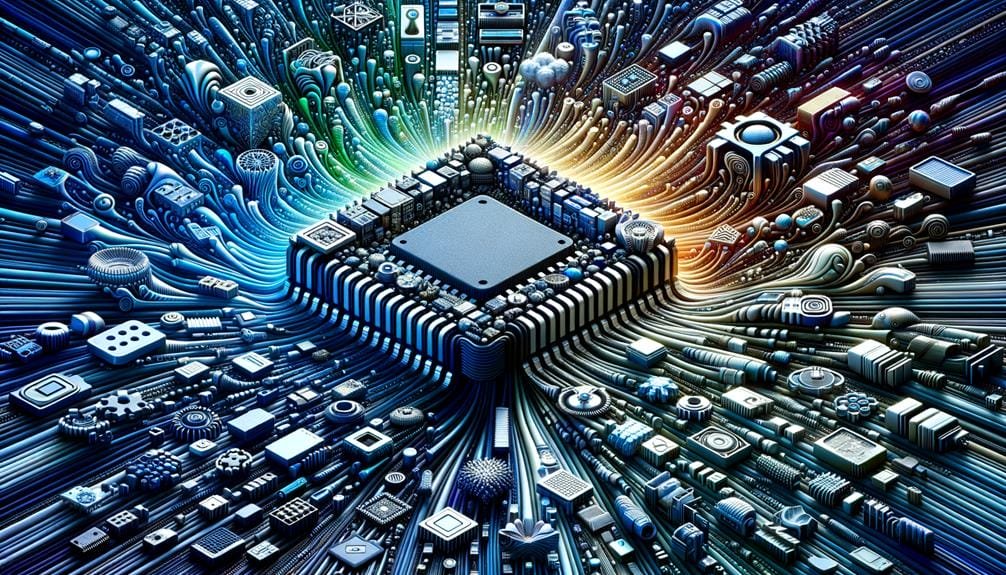Our Newsletter
Sign up for our e-mail newsletter and stay informed for what’s next on the horizon.
Visualize the core of your computer, a minuscule chip where crucial data is protected, never to be changed or deleted – that’s the essence of ROM memory.
We’ve all heard about it, but do we genuinely comprehend its significance in our technology-dependent lives?
Today, we’ll journey together to learn nine critical insights about ROM memory, from its progression to its effect on software and potential future developments.
Interested? Keep reading, there’s a wealth of information ready for you to grasp.
In conclusion, we’ve examined ROM memory, its evolution, and its comparison with RAM. We’ve identified its critical function in the operation of computers and mobile devices, its abilities and restrictions, and its importance in system booting.
We’ve also explored its impact on software and potential future enhancements. It’s fascinating how ROM, a constant, unchanging technology, remains fundamental in our advancing digital era. Therefore, we’ll continue monitoring this sector for more ROM developments!
Let’s move forward in understanding ROM memory, a non-volatile storage medium that keeps vital data and instructions, guaranteeing smooth startup operations and efficient hardware communication in computers. ROM, or Read-Only Memory, is a kind of memory that stores data that isn’t easily changed or removed. This ensures system consistency and dependability, two notable benefits of ROM.
ROM is typically employed to store firmware, the basic software that enables hardware components to interact effectively. The data in ROM remains even when power is disconnected, making it a critical component of every computer system. It’s akin to the computer’s DNA, holding the instructions it requires to boot up and function correctly.
Representative examples of ROM include CD-ROM and DVD-ROM. These mediums keep data permanently, even without a steady power supply. This non-volatile characteristic of ROM is another benefit that leads to its extensive use in various electronic devices.
In tracing the progression of ROM technology, we start with its initial phases, highlighted by MaskROM and its successors, PROM and UV-ROM.
As we proceed, we’ll examine the notable breakthroughs such as the rise of EPROM and the groundbreaking introduction of Flash Memory.
Ultimately, we’ll evaluate the deep influence these developments have had on the production of more trustworthy, adaptable, and efficient non-volatile memory resolutions.
The history of ROM technology dates back to the 1940s with the creation of the Selectron tube, which marked the beginning of using ROM in computers. The progression of ROM took a substantial leap in the 1960s with the advent of PROM. EPROM made its appearance in the 1970s, succeeded by EEPROM in the 1980s.
Flash memory, a form of EEPROM, brought significant changes to ROM technology in the 1990s. It offered the flexibility to delete and reprogram data electrically, eliminating the need for UV light. Here’s a concise overview of this initial development:
| Decade | ROM Development |
|---|---|
| 1940s | Selectron Tube |
| 1960s | PROM |
| 1970s | EPROM |
| 1980s | EEPROM |
| 1990s | Flash Memory |
This progression of ROM technology paved the way for further advancements.
ROM technology has significantly progressed over time, transitioning from the conventional mask ROM to the more adaptable and spacious contemporary flash memory. This transition has introduced PROM, EPROM, and EEPROM variants, providing reprogrammable features that were unimaginable in the early years.
Flash memory, in particular, transformed data storage by offering erasable and rewritable memory, providing users the liberty to modify data at their will. Significantly, NAND and NOR flash memory have emerged, which are now commonly found in devices such as USB drives, SSDs, and mobile phones.
These improvements have greatly enhanced data storage efficiency, dependability, and performance, demonstrating the persistent innovation within the ROM technology field.
Drawing upon these advancements in ROM technology, it’s vital to comprehend the impact of its progression, particularly how it has transformed data storage, retrieval, and device efficiency.
The shift from conventional maskROM to contemporary flash memory has noticeably increased storage capacity and quickened access speeds. This progression hasn’t only enhanced data storage but also made data retrieval more streamlined. The emergence of portable storage gadgets like USB drives and SSDs is a direct consequence of this development.
Furthermore, the ongoing progression of ROM technology has substantially improved the dependability and efficiency of electronic devices, providing us the liberty to store and access vast quantities of data spontaneously. Hence, ROM’s progression signifies a significant leap in digital data management.
Let’s proceed to contrast ROM with RAM to fully comprehend their unique functions in computing.
It’s essential to remember that ROM’s persistent nature and lesser data capacity stand in stark contrast with RAM’s transient nature and greater storage capabilities.
We’ll analyze these variances and talk about how ROM’s distinct features provide specific benefits.
Delving into the technical details, we notice numerous distinctions between ROM and RAM, two crucial parts of computer memory systems. ROM is a non-volatile memory, implying that it keeps its data even when the power is turned off, acting as a vital data holder for firmware and boot instructions.
Conversely, RAM is a volatile memory, used for ongoing tasks, and it loses its data once the power supply is interrupted. ROM chips generally house several megabytes (MB) of data, in sharp contrast to RAM’s ability to accommodate multiple gigabytes (GB) of data.
Both are essential yet different, with ROM supplying hardware communication instructions, and RAM supporting ongoing tasks. Essentially, they perform unique functions in ensuring a computer’s peak performance.
When we look at ROM and RAM, it’s clear that the non-volatile characteristic of ROM gives it a notable advantage. It holds essential data even when the computer power is turned off. This built-in data preservation feature enhances its reliability, making ROM a crucial part of computer systems.
The reliability and cost efficiency of ROM further highlight its superiority. It’s a reliable protector of firmware and fundamental processes, ensuring a smooth and uninterrupted operation. Here’s a side-by-side comparison:
| Specification | ROM | RAM |
|---|---|---|
| Data retention | Yes | No |
| Volatility | No | Yes |
| Cost | Less | More |
Our digital experience-seeking users will appreciate the non-volatile, reliable nature of ROM. It provides a smooth and seamless digital experience, free from the worry of losing vital data. RAM, although important, simply cannot compete with the steadfast data protection offered by ROM.

To grasp the vital role of ROM in computers, it’s key to comprehend that this form of memory saves firmware providing crucial instructions for hardware interaction. This firmware, stored within the ROM, is essential to the computer’s functioning. It preserves data even when the power is off, guaranteeing that important information is always at hand.
ROM houses the BIOS – the Basic Input/Output System. This is in charge of initializing hardware elements during booting. Without it, a computer wouldn’t comprehend how to interact with its hardware, rendering it ineffective. It serves as a universal translator between the operating system and the hardware, making it a necessary component of any computer.
ROM chips in computers usually save several megabytes of data. This data is vital to basic system tasks, offering a dependable and constant storage solution.
The utility of ROM complements that of RAM in computers, establishing a crucial pair for proficient system processes. Whereas RAM provides instant memory for running applications, ROM ensures that the fundamental firmware and system instructions are always present. Hence, ROM’s function is to offer a sturdy foundation for the computer’s functioning, promoting ease of use and dependability.
Much like how ROM is integral in computers, it serves an equally pivotal role in mobile devices, storing firmware and crucial system directives necessary for seamless functioning. To initiate the operating system and enable communication between hardware components, mobile devices employ embedded ROM. It ensures that key software programs are perpetually accessible, guaranteeing system integrity.
Although mobile devices tend to have less ROM capacity compared to computers, they contain enough to execute essential operations. This ROM is crucial for preserving system integrity and stability, particularly during software upgrades and system resets.
Here is a table for a clearer depiction:
| Mobile Devices | Embedded ROM | System Integrity |
|---|---|---|
| Keeps Firmware and System Directives | Enables System Start-up and Hardware Communication | Sustains Stability During Upgrades and Resets |
| Reduced Capacity but Adequate for Operations | Vital for Device Functionality | Upholds System Integrity |
| Perpetually Accessible for Key Software Programs | Fundamental for Hardware-Software Interaction | Shields Against System Failure |
| Guarantees Seamless Device Functioning | Backs OS and Application Processes | Ensures Consistent Device Performance |
| Critical for Software Upgrades and System Resets | Certifies Reliable Device Start-Up | Averts System Corruption |

While the non-volatile nature and essential role in system operations of ROM represent its advantages, it also bears certain constraints that are noteworthy. The ROM sector has witnessed substantial expansion, however, its constraints can influence the Read-Only Memory (ROM) Market report.
The abilities of ROM are characterized by its function to store firmware and crucial boot-up instructions, establishing its necessity for device functioning. Nevertheless, the interaction between ROM and RAM illustrates some constraints. ROM is read-only, suggesting it can’t be effortlessly rewritten or adjusted, unlike RAM which permits for read and write processes.
Here are some limitations of ROM:
In spite of these constraints, ROM continues to be a vital component in computing systems, its non-volatile characteristic and role in system operations guarantee its ongoing significance in the market.
Have you ever pondered how your computer magically turns on with just a simple press of a button? This fascinating phenomenon is made possible by the ROM, or Read-Only Memory, which has a key role in the vital process of system booting. ROM holds the fundamental instructions required to boot the computer, acting as a link between the power button and the operating system.
During the boot-up phase, the BIOS (Basic Input/Output System) housed in the ROM conducts a Power-On Self Test (POST). This indispensable examination confirms all hardware elements are in optimal working condition before the computer becomes fully functional. Thus, the BIOS serves as a security guard of sorts, validating that all is well before permitting access to the remaining system.
The firmware in the ROM also activates hardware components like the CPU, memory, and peripherals during booting. This can be likened to a maestro leading a symphony, ensuring each component is performing its role at the correct time.
ROM also preserves critical system settings even when the computer is switched off, guaranteeing a flawless shift between power cycles. Finally, ROM provides the indispensable instructions for the computer to find and load the operating system from storage devices like hard drives or SSDs. Therefore, the role of ROM in system booting is fundamental, ensuring a smooth and effective start-up process each time you turn on your computer.

Delving into the function of ROM in system boot-up, we’ll now examine how ROM substantially affects software operation through the storage of the firmware necessary for effective hardware communication. ROM is critical to software operation as it accommodates the firmware that contains key instructions for the computer’s initial boot process. This establishes an essential connection between hardware and software, guaranteeing smooth interaction.
The significant influence of ROM on software applications can be condensed into the following points:
Looking ahead to the future of ROM technology, we anticipate exciting progress like amplified flash memory capacity, increased speed, heightened performance, and superior energy efficiency. The ceaseless drive towards technological progression promises to transform the ROM industry.
Imagine a future where ROM technology isn’t just quick, but ultra-fast due to augmented data transfer rates. Visualize the expanded capacity of flash memory, boosted by innovative materials and structures, providing unmatched memory density and robustness. We’re talking about a future where ROM’s reliability isn’t just presumed, but is assured.
However, it’s not solely about speed and capacity. Future advancements also include energy efficiency. In our current world where power consumption is a critical issue, the focus is on developing ROM solutions that aren’t just potent, but also energy-conserving.
Furthermore, the convergence of ROM with artificial intelligence is being considered. This merging is expected to amplify data processing capabilities, propelling ROM technology into unexplored domains.
‘Our topic is ROM, also known as read-only memory. This type of non-volatile storage holds onto its data even when there’s no power. Users aren’t able to alter ROM and it holds a crucial role in connecting hardware and initiating the computer start-up process.’
We are examining five distinguishing features of ROM: its non-volatile nature, acting as a consistent guide through turbulent times; it houses firmware; it’s not alterable by the user; generally, it comprises several megabytes; and it’s manifested in formats such as CD-ROM and DVD-ROM.
ROM memory is tasked with holding static data and guidelines. This element is indispensable for starting up computers and facilitating communication with hardware components. The data in ROM memory remains intact even when the power is off, making it an important part of a computer.
Frequently, we’re posed with the question, ‘what’s the primary focus of ROM?’ The answer is straight forward, it’s a type of memory that is non-volatile and stores vital system instructions permanently, guaranteeing that hardware runs as intended even when power is lost. It’s vital for our digital autonomy.
In summary, we’ve studied ROM memory, its progression, and its juxtaposition with RAM. We’ve uncovered its vital role in computer and mobile device operation, its capabilities and limitations, and its significance in system startup.
We’ve also investigated its influence on software and possible future improvements. It’s intriguing how ROM, a fixed, unwavering technology, is central to our progressing digital world. So, we’ll keep observing this area for further ROM advancements!
Sign up for our e-mail newsletter and stay informed for what’s next on the horizon.